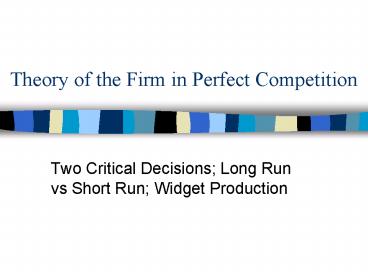Theory of the Firm in Perfect Competition - PowerPoint PPT Presentation
1 / 21
Title:
Theory of the Firm in Perfect Competition
Description:
In long run firm's choose K and L to produce planned output at lowest cost. Short run production is characterized by diminishing marginal returns. ... – PowerPoint PPT presentation
Number of Views:68
Avg rating:3.0/5.0
Title: Theory of the Firm in Perfect Competition
1
Theory of the Firm in Perfect Competition
- Two Critical Decisions Long Run vs Short Run
Widget Production
2
The Firms Problem
- Maximize profit p
- Given available technology Q(K,L)
- Given prices of inputs w and r
- Given price of final good Q
3
Two Critical Decisions
- How to produce?
- List technically efficient methods
- Choose the lowest cost method L,K
- TC(Q)wLrK
- How much to produce?
- Profit Total Revenue-Total Costs
- Total RevenuePQ
- Total CostsTC(Q)
4
Total Revenue-Total Cost
5
Profit
6
Profit Maximization Rule
7
Some Basic Vocabulary
- Explicit costs vs Implicit costs
- Explicit costs require an outlay of money by
firm Implicit costs do not. - Economic Profit vs Accounting profit
- Economists include opportunity costs in
calculating economic profit Accountants do not. - Long run vs short run
- In long run both K and L are variable. In short
run, K is fixed Only L is variable.
8
Short Run Production
- Widget manufacturing
- Variable Input -- Labor (Staples)
- Fixed Inputs -- Table, Stapler
- Production Table
- Total Product -- total number of widgets
- Average Product -- total number of widgets
divided by total number of workers - Marginal Product -- change in number of widgets
following addition of worker
9
Discussion
- What happens to marginal product as number of
workers increases? - What happens to total costs as number of workers
increases? - What happens to cost per unit produced as output
increases?
10
Short Run Costs
- Fixed vs variable costs
- ATCTotal Cost/Output
- AVCTotal Variable Cost/Output
- AFCTotal Fixed Cost/Output
- MC DTC/DQ
- Change in Total Cost associated with last unit
produced
11
Typical Short Run Cost Curves
12
Marginal Cost
- Marginal cost is inversely related to marginal
product. - Because of the law of diminishing marginal
returns (diminishing marginal productivity),
short run marginal cost slopes up. Why is that
important? - Marginal cost will intersect AC at minimum of AC.
13
Long Run Production
- Plans Output (Q)
- Firm chooses K and L to produce Q at lowest
possible cost - Chooses among technically efficient technologies
(combinations of K L)
14
Technically Efficient Technologies Q20
15
Cost Minimizing Technology? w5 and r10
16
Long Run Production
17
Long Run Total Costs
18
Returns to Scale
- Increasing Returns to Scale
- As inputs double, output more than doubles
- Average total costs are decreasing
- Constant Returns to Scale
- As inputs double, output doubles
- Average total costs are constant
- Decreasing Returns to Scale
- As inputs double, output less than doubles
- Average total costs are increasing
19
Relationship between Long Run and Short Run Costs
- Short run, K is fixed. Only L variable
- Suppose firm built factory with K2, anticipating
production of 40 units. - If output is 20 instead, firm will have total
costs of 30 and SRATC of 15. SRATC would be
greater than LRATC.
20
Relationship between Long Run and Short Run Costs
21
Summary
- For economists, cost is opportunity cost. It
includes the opportunity cost of capital invested
in firm. - In long run firms choose K and L to produce
planned output at lowest cost. - Short run production is characterized by
diminishing marginal returns. - MC will intersect ATC at ATCs minimum.
- Minimums of SRATCs will be tangent to LRATC































